By Michaele Jordan.
- The Daughter of Doctor Moreau by Silvia Moreno-Garcia (Del Rey)
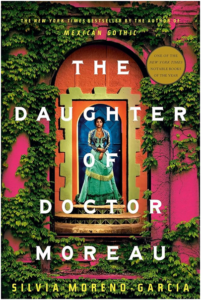
In The Daughter of Doctor Moreau, Ms. Moreno-Garcia re-examines a story that has been intriguing us for well over a century. The original novel, The Island of Doctor Moreau by H.G Wells, was published in 1896. It was followed by three movies. The first, made in 1932, was titled The Island of Lost Souls, and starred Charles Laughton and Richard Arlen. In 1977 it was remade under the original title, The Island of Doctor Moreau, and starred Burt Lancaster and Michael York. It was remade again in 1996, with Marlon Brando and Val Kilmer.
The story deteriorated over the years. H.G. Wells was an ardent social activist, particularly appalled by the then common practice of vivisection. His book was intended to highlight its horrors. It was a serious novel, and was not well received at first, specifically because it was so horrifying. The 1932 movie was excellent. I saw it years ago, and the memory still gives me shivers. It’s a little hard to find these days. It’s on YouTube, but mixed in with numerous adulterated versions. You have to hunt for it. Then the 1977 movie was very bad, and the 1996 version went beyond bad to utterly dreadful. Fortunately, Ms. Moreno-Garcia’s novel restores the tale to its former stature.
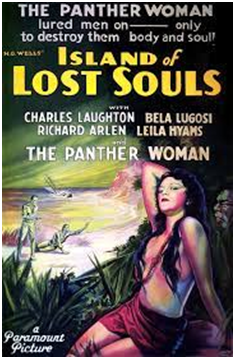

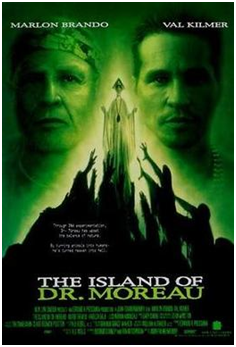
The basic story remains the same. A stranger comes to the island. Usually he’s marooned, although in the new book [INB], he’s a new hire. (Because, yes, Dr. Moreau needs staff.) He finds a deserted jungle island (or INB, a nearly deserted jungle island) with only two visible residents: Dr. Moreau, and a beautiful young woman identified as his daughter. They are surrounded by a group of misshapen, inarticulate persons, either his servants or his patients. We soon learn that Moreau is engaged in what modern SF calls ‘uplift’, transforming animals into humans.
His technique varies – depending on which version you’re looking at – from vivisection to DNA injections. But he’s having trouble making his process work. The resulting creatures do not look fully human, and have trouble with human speech (many cannot talk at all.) Even apparent successes tend to revert to their original forms and behaviors. The introduction of a stranger into this mélange greatly disturbs the social balance, and the whole project erupts into violent conflagration from which the stranger and the beautiful woman narrowly escape. Just in case one of you has somehow evaded this story until now, I will not reveal the surprise ending.
So what does Ms. Moreno-Garcia have to add to this outline? As her title suggests, she makes the beautiful woman, Carlotta, the viewpoint character. Carlotta is entirely concerned with the people around her. Of course she knows where her friends came from. But they are her friends, her day-in-day-out companions, her family.
She never gives a second thought to the morality of a practice she’s grown up with. She assists her father in his work, as his nurse, administering medications and tending injuries. She accepts her father’s creations as her fellows, and takes pleasure in providing them with the special care they need.
Ms. Moreno-Garcia has also expanded the environment. Dr. Moreau is not working on an uninhabited island, just a thinly populated one. A good ways down the road, there’s a city where supplies can be purchased and travel arrangements made. There are neighbors within a day’s travel. He has a very large tract of uninhabited land, but he doesn’t own it – he rents it. His landlord is extremely interested in his work, and is providing the financing
This leads to a major shift in focus. In previous versions, the thematic emphasis was on the cruelty of the procedure. Even the later variants, where vivisection is replaced with DNA injections, the process is depicted as hideously painful, producing creatures who could not possibly have lived independently. But in this more modern work, the procedure is accomplished by subjecting the embryo to genetic changes.
Doctor Moreau may not be inflicting his creations with physical torture, but he is instead subjecting them to a subtler, crueler torture. He is breeding slaves. His landlord expects to acquire workers in exchange for the financing.
I don’t doubt you can plainly see that these changes must make a major difference in how matters play out, and I strongly encourage you to read the book and find out where the story now goes. The Daughter of Doctor Moreau is a fine book.
- The Kaiju Preservation Society by John Scalzi (Tor Books) (Beware spoilers)
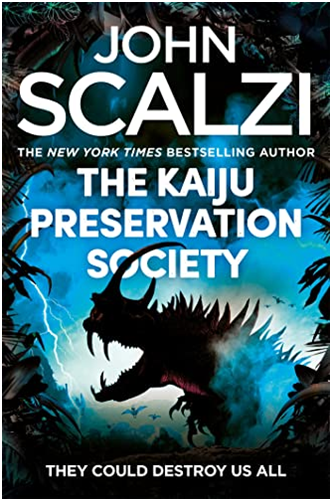
Do you remember when John Scalzi’s first novel, Old Man’s War came out? (Okay, it wasn’t actually the very first – it was his first traditionally published book.) It was back in 2005, and at the time there was a lot of joking about how he was channeling Robert Heinlein. But it was happy joking. Robert Heinlein, who had been with us since we were children, had been gone for seventeen years, and we missed him sorely. We were happy to have his voice back.
That was pushing twenty years ago, and Mr. Scalzi has published a lot of novels since then. And you know what? He’s still channeling Heinlein.
I thought that The Kaiju Preservation Society read just like a Heinlein juvenile. The parameters for a juvenile are not the same as those for an adult work. Characterization tends to be simplistic. So-and-So’s a prankster. Who’s-it is obsessed with dinosaurs. Goody-two-shoes has to be talked into everything, but always bring snacks. Kids are still learning their social skills, so you give them plain markers. Action – even in an ‘action’ book – tends to be a little minimal. (You don’t want to scare the kids.) And there’s lots and lots of explanations.

The Kaiju Preservation Society runs 258 pages, in 28 chapters. The first four chapters are the basic set up. We meet Jamie (the protagonist) and Rob (the bad guy). We see the circumstances that pull Jamie into the story. And at the end of chapter four (page 35) we get the exciting reveal of where he’s going and why – earth in an alternate dimension! With real kaiju! Of course, we already know those things from the liner notes, but we assume that’s just the beginning.
So in chapters five, six, and seven the staff is introduced. They explain the basics of the place – how they got there, and what they’re doing, and how it’s possible for the kaiju to exist. (That’s an issue for all the newbies.)There’s lots of odd but interesting information about the creatures. They seem to be organic nuclear reactors.
There’s a transportation system which is, naturally, unique to the environment, and constructed entirely on site with local materials). En route to the local base, there’s a close visual sighting. Yes, these critters are enormous and yes, they are insanely dangerous. The beastie snarls, and its teeth are the size of cars. It throws a tree at them. But the staff aren’t really in danger. Their pilot is a genius (like everyone else on the staff), and quickly flies them away. The biting insects prove to be the bigger nuisance. The reader learns who’s the boss and who knows how to play a ukulele.
In chapter eight, our protagonists are provided with special kaiju-jungle clothing and operations manuals. Chapter nine opens with the discovery that the coffee is terrible. “Wait a minute!” I hear you cry. “Are you going to go over this book chapter by chapter?”
What? You’re bored already? Have you murdered your inner child? I ask, because if you were ten years old, you would find all this convincing detail fascinating. I’m not being snarky, honest. Young readers – or rather young persons, whether they are reading, or not – absorb huge amounts of random data. They are still determining for themselves the parameters of their interests and what details may prove relevant. When I was thirteen, I was thrilled to discover Paul McCartney’s shoe size. A kid I knew had been to Paris over the summer. He told everyone he saw how many steps there were in the Eiffel tower.
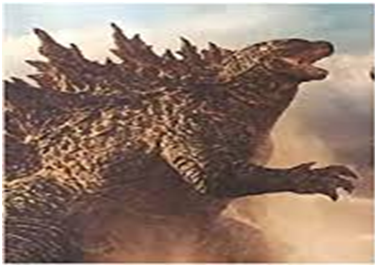
But none of us are kids anymore. So I’ll try to speed this up. Chapter nine continues with pheromones. That’s important. It provides the staff with a means to direct kaiju behavior to a limited extent. The scientists are hoping to observe nesting and birthing procedures, so they attempt to provoke a mating interaction. In the meanwhile, we learn about their parasites. (Kaiju have lots and lots of parasites.) And when they’re dying they head to water. And when they die, they explode. (The staff learned that the hard way. Their original base was located on a lake shore.) The nuclear explosions are taken in stride by the local fauna, but strangely, they seem to thin the barrier between the worlds.
There’s an interlude in which tourists (very important tourists) visit the base. Among them is the bad guy we last saw back on earth. (He’s rich. Very, very rich.) He’s still a pig. He is surprisingly interested in the kaiju, and tries (with becoming incompetence) to steal some souvenirs. We had not previously suspected he was interested in anything but money. Jamie takes him aside and tells him he’s no longer welcome, and if he ever tries to come back, a recording of the attempted theft will reach a lot of authorities.
The pheromones worked! Bella (a female kaiju) is pregnant! The base already uses aerial cameras to keep a bird’s eye view on the local kaiju. But now the scientists are not as thrilled to settle for aerial cameras anymore. A mission is launched to set up close range cameras, so they can observe Bella’s nesting behaviors, and her eggs.
You see nothing wrong with any of this. And you are right. If you were a scientist – in any of a number of fields – you would probably kill for the opportunity to go on a mission like this, and see such things first hand. You would be fascinated by every procedure, either for capturing data, or protecting the staff. You would revel in each tiny little discovery.

But the reader is mostly watching other people make notes. For all that their surroundings are thrilling, not much actually happens. It’s like watching a movie about some guys on a roller coaster, and all the silly jokes and gossip and lifelike workplace grumbling just don’t make it more interesting. (At least not to me. I don’t doubt that Mr. Scalzi found it interesting, because he was doing the inventing.) The description of other people studying interesting stuff in an interesting place continues for one hundred fifty pages.
On page 220 (the end of chapter 24) planning of the next move is complete, and action is initiated. Things are very exciting for three chapters (32 pages) and on page 252, the heroism is completed and the six-page wrap up commences.
- Legends & Lattes by Travis Baldree (Tor Books)

There is not a lot to say about Legends & Lattes. It describes itself as “A Novel of High Fantasy and Low Stakes,” which is fair enough. It is a simple, gentle book about a seasoned warrior retiring from the fight to set up a coffee shop. It qualifies as high fantasy because none of the main characters are human.
They’re all mythical creatures. The protagonist, Viv, is an orc. Her former colleagues are an elf, a gnome and a dwarf. Her new friends, who assist in her endeavor, are a succubus, a hob, and a ratkin. They are joined later by Pendry, who may be human. (He’s described in one review as a bard). One character (almost certainly a fan favorite) is not even humanoid, but a dire-cat. Dire or no, this cat is a classic house kitty – except she’s the size of a Saint Bernard (or maybe even a pony). But other than the cast list, there’s not a lot of magic in the story.
Viv acquires a magic artifact at the beginning of the book. We see her claim it after a battle, as her share of the spoils. It is her possession of this artifact that inspires her to sheathe her sword and set up shop in the city.

They say any story needs some conflict. The action in this story derives from one of Viv’s former comrades deciding that she was not entitled to scoop up that artifact and take off with it. I had a little trouble with that. As I said, we see Viv claim the artifact. She did not sneak – she claimed it in plain sight. None of her companions objected at the time. And none of them supported their team-mate’s later objection.
You are probably getting annoyed with me for going on about the “artifact” without telling you what it is. But to say more would be a spoiler, as much of the book debates that very question. The rest of the story is a hymn to the pleasure of a really great cup of coffee. I was surprised to see such a light-weight book on the list of Hugo nominees. It doesn’t really deserve any awards. But I didn’t hate it. Like a P.G. Wodehouse novel, it made me chuckle often.
- Nettle & Bone by T. Kingfisher (Tor Books)
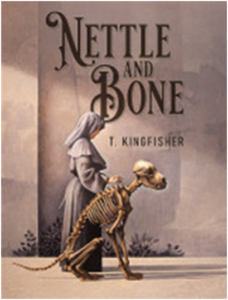
I blush to admit that I had never read anything by T. Kingfisher before this Hugo season. Now I’ve read two. And as soon as I finish my Hugo reading, I am going to go hunt up her previous work, Ms. Kingfisher has accomplished that rare task: she writes stories that are deeply grounded in the fantasy traditions, and yet are completely original.
In Nettle & Bone we find royal palaces and the Goblin Market, villains armed with ancient swords and princesses in danger, magical godmothers and witches raising the undead. And yet none of these things are remotely like the tropes as you’ve seen them a thousand times. And yet they all conform to the basic concepts, and do (or don’t do) all the things that their position in fairy-lore calls for.
The protagonist is Marra – she’s the third daughter of the king and queen of Harbor Kingdom. It’s a small place, sandwiched in between two larger, stronger and richer kingdoms. It only exists because it has a really good harbor, and each of the neighboring kings would dearly love to march in and grab that harbor, but can’t, for fear that the other neighboring kingdom would quickly intervene. So – since the Harbor Kingdom has no sons – the Northern Kingdom decides to acquire it by marrying into it.
Right away we have a selection of glamorous royal courts, which somehow fail to sound romantic, because none of that glamor can penetrate the stench of ugly, grasping politics. Marra is sent off to a convent after the two elder sisters are married. When was the last time since Malory’s Morte D’Arthur that you saw a convent mentioned (or even presumed to exist) in a high fantasy? In Nettle & Bone, convents, despite their religious associations, are maintained by the rich and powerful who use them to dispose politely of excess women.

Ms. Kingfisher does this again and again: introduces an element to her fantasy that is startlingly practical and realistic. Marra loves the convent, because she can close her bedroom door there, and she doesn’t have to spend an hour being dressed by servants every morning. She doesn’t have to watch her tongue or keep an eye out for a backstab every minute of the day. She gets very good at embroidery, and picks up some nursing skills
Very few fantasy novels note that quests are generally composed of trudging through bad weather carrying a heavy load. When Marra and her companions cross the Blistered Land, they have to sleep on the ground in the snow, and share one egg amongst the three of them for breakfast. Here, magical godmothers are not routinely happy in their work. Royalty are almost always vicious and paranoid. Ghosts carry pointless grudges, and are often difficult to identify. Demons occasionally possess chickens. No single victory, however great, sets the world to rights. It just pushes the world in a slightly different direction.
Marra’s interior monologue is wonderful – the reader feels like they are talking to an old friend. She is so normal, so relatable, she makes everything around her feel real. She worries about everything. She constantly second-guesses her past actions, and barely notices her successes. She wonders what her friends think of her, and worries they will desert her. The only thing she doesn’t agonize about is her quest. She already knows it’s hopeless. She does it anyway.
And most of all, despite Nettle & Bone being about a magical quest to rescue a princess, it is completely original. (I wouldn’t have thought that was possible!) Even the ending is not what you expected. Read this book!
- The Spare Man by Mary Robinette Kowal (Tor Books) Beware spoilers.
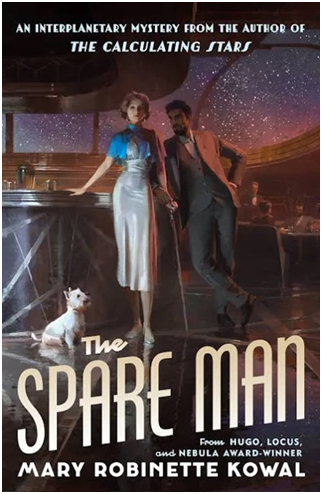
The Spare Man is officially a cozy mystery, a book in which there is no explicit or grisly violence, permitting the reader to focus on solving the mystery, without having to gag on the blood and guts. (These mysteries are not usually very complex or difficult, so that the reader doesn’t get frustrated with the puzzle, and skip to the end to find out who did it.)
You could even say that The Spare Man is a ‘country house mystery’ since it takes place in a closed environment. Of course, the usual purpose of setting the mystery in a closed environment is to limit the number of suspects and associated locations. Ms. Kowal did not take advantage of that option, as The Spare Man is set on an intra-solar luxury cruise ship, as large as an entire city, only far more difficult to navigate.
Despite that, The Spare Man is definitely a cozy mystery. Really. Ms. Kowal doesn’t miss a trope. She starts out with Nick and Nora Charles (here, named Shal and Tesla), and their adorable little dog. Of course, Shal, a detective, is first on the scene after the murder. And of course, he is immediately charged with the crime. The surly and bigoted Chief of Security beats him brutally, presumably in hope of extracting a confession. Or maybe just for fun.
So Tesla has to run all over the ship, trying to solve the mystery, although she’s not a detective, and although she and Shal have agreed not to infuriate the authorities by interfering. Tesla is an insanely wealthy interplanetary celebrity, who is so plagued by fans that she has to travel under an assumed name. Her fans swarm her as if she were Beyoncé, because – wait for it – she was a brilliant roboticist seven years before.
I had a problem with this. Even on this tiny little island earth, I do not see a lot of scientist/engineers becoming major celebrities. Carl Sagan is the only scientist that I can think of who was so famous that I would recognize his picture when I saw it. And fame in the US doesn’t have to penetrate all the way to the moons of Saturn. (By the way, natives of Titan are called Titians, and they have their own music forms. For a while I thought they’d named their flute after a 16th century painter)
But Tesla has another claim on fame. She’s a tragic victim. She has steel bolts all up and down her spine, and still often needs the help of a cane to walk. She’s in pretty much constant pain, although she doesn’t let that interfere with her love life. Seven years earlier she was involved in an Accident. For over half the book the event is always referred to with an ominous capital A.

Eventually we are told that a PAMU (some kind of personal mobility unit for the handicapped) malfunctioned during testing. It was apparently in, or attached to, some kind of off-earth vehicle which had, in turn, been launched from an orbital laboratory. The attempt to disengage resulted in a ricochet, causing the vehicle to crash into the laboratory, killing six and crippling Tesla.
Aside from the steel bolts in her spine, Tesla was also assigned a service animal, with electronic implants which improve its ability to communicate with and assist its owner; hence the dog. I give Ms. Kowal full credit for having a really good idea: a cyborged service animal. Somebody should look into that.
Unfortunately, Ms. Kowal didn’t waste a lot of words on explaining the dog’s enhancements or abilities. To the reader’s eye, the dog was simply a hugely loyal companion. And terminally cute. EVERYBODY fell in love with that Westie on first sight. Strangers crossed the room to come pet Gimlet – and had to be warned off. (It really is very inappropriate to stroke a service animal.) Business associates made appointments to stop by for a play date. It was actually stated in so many words that if you don’t care for dogs, you’re a bad person. Personally, I have cats.
I don’t hate dogs. I used to work in a kennel. I’ve stopped now and then to pet a neighbor’s dog, while saying hello to the neighbor. But playdates?
As you can see, I am not being the target audience for this novel. I don’t care for mysteries and I detest romances. So, I started yawning as the familiar mystery tropes floated by, and squirming at all the love scenes. I got very, very bored with people talking baby talk to the Westie. But if you do like mysteries and/or romances you should be fine.
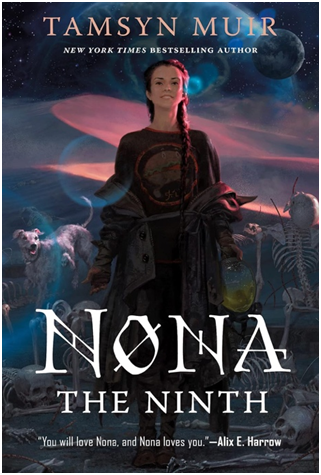
Friends, I sat down here intending to write up all six of the novel nominees. But, when I picked up Nona the Ninth by Tamsyn Muir (Tordotcom), I discovered that it was the third volume of The Locked Tomb Series. I do not like to read series out of order. And even if was I okay with that, I saw the note in Wikipeda warning me not to attempt to read the books out of order. “You’ll never catch up,” the note read. “You’ll just get confused and give up reading it,” I was warned. So I heaved a sigh, and went to the library. It turned out that Gideon the Ninth (Volume 1) is extremely popular. There are 27 holds on it. I didn’t even look for Harrow the Ninth (Volume 2). So these are just my notes on the five that I’ve actually read. Perhaps I’ll get back to you with my thoughts about The Locked Tomb Series. Catchy title.
Discover more from File 770
Subscribe to get the latest posts sent to your email.

Nona the Ninth was the one Hugo nominated novel I did not read. I did not like the first one and did not get through the second one so I read and enjoyed the others. I recommended The Spare Man to my sister who is not an SF fan because it is simply a cozy mystery with likable characters. I am a cat person and loved the Westie (I had to look that up so I could visualize the dog, essentially a white Scotty) I did not realize it was enhanced. There are some pretty smart dogs out there.
“The Kaiju Preservation Society” did not impress me. For a MUCH better and funnier and more thoughtful young adult book [that’s still quite enjoyable for adults] on Kajiu and/or other monsters, with a lbit of Doctor Moreau-esque genetic engineering thrown in, find and read Laurence Yep’s “Monster Makers, Inc.” Yep always delivers.
Small correction to a typo in Michaele’s review of The Kaiju Preservation Society: in 2005 Robert Heinlein had been gone for 17 years, not 7.
Oops! Must have been a typo. Or maybe I forgot to carry a one. You are right, of course. Thanks for setting the record straight.
The Kaiju Preservation Society–Yes, you’re being snarky, and making very clear your opinion that anyone who enjoys a well-done Heinlein juvenile is mentally a child. Including those of us who loved and appreciated The Daughter of Doctor Moreau–no, wait, you probably think it’s impossible for the same person to have enjoyed both, because you go on in the other reviews to make clear that your tastes really are that narrow.
The Spare Man–Tesla was a roboticist who was also an effective science popularizer, like Carl Sagan, and also Isaac Asimov, Neil deGrasse Tyson, Michio Kaku, Stephen Hawking, and others. Another scientist who was widely famous and widely recognizable in his day was Linus Pauling. And, who was that other guy, the one whose picture is still widely recognized, decades after his death? Oh, yeah, Einstein!
Tesla was a leading roboticist and a widely popular figure due to her science promotion activities, and then she was nearly killed and badly injured in a tragic accident, doing work intended to benefit others. She subsequently married a detective who was very successful and became the star of a TV about solving cases, which became wildly popular and then ended badly. He has both passionate fans and passionate haters.
Yes, it makes sense that they need to hide from their respective publics.
Gimlet is a service dog. A small, cute, fluffy, service dog. I have one myself. Yes, they are magnets for intrusive dog petters. No, it’s often not obvious when they are doing their jobs, and idiots interfere sometimes. Service dog handlers have a variety of ways have handling this problem, and Tesla has the personality and skills of a successful businesswoman and celebrity. Her way makes sense for her. The attentive reader, and not just the ones with service dogs, do indeed see Gimlet doing her job. Kowal has a service dog handler in her family, though not a small service dog, and she gets it right.
And–you don’t like cozies. I get it. But “not usually very complex or difficult, so that the reader doesn’t get frustrated with the puzzle, and skip to the end to find out who did it” just strikes me as pointlessly condescending and dismissive. I didn’t say anything similarly nasty about Gideon the Ninth and those who loved it, and strongly recommended it to me, even though reading that book is why I didn’t even consider reading Harrow the Ninth. You seem real big on showing a lack of respect for people who like well-down work of a kind that you dislike.
Another who did not read Nona. Bounced off Harrow, left it till last. Didn’t get time to read everything.
I’m with you on The Spare Man. I just hated all the characters. I’ve enjoyed MRK before, but this one was so not for me.
“It qualifies as high fantasy because none of the main characters are human.”
Is that the standard now? 🙂
Sounds about right. I’m currently trying to read the second book, about eighteen months after having read the first, and finding it confusing. I may need to go back and reread the first book. Not only is it set in a far distant future with no connection to the present, the narrators are only marginally sane, profoundly ignorant of almost everything, and what they do know is probably wrong.
There’s a weekly review post at Daily Kos; the reviewer did Gideon and Nona chapter-by-chapter, and I still don’t want to read either book. That reviewer did enjoy Oor Wombat’s books, though.
Nickpheas: I did read Nona, and while it had a lot of emotionally touching YA-type moments that made me care about the characters, I really disliked the persistent feeling that the story hadn’t started yet, and that by the end there had been so little movement toward resolution of the supposed challenges they faced.
As for The Spare Man, to me it was hugely handicapped by deliberately setting up the comparison to Dashiell Hammett’s The Thin Man. Here’s just one example. In The Thin Man, Nick charms and works people from all levels of society. In The Spare Man, the detective character antagonizes and conflicts with a wide swathe of the people she interacts with. So while I thought, sure, Kowal was faithfully portraying a rich and intelligent character, I don’t need to read a book about somebody who’s almost as charming as Elon Musk.
I read whatever it was the ninth a year or two ago, and disliked it. Too much seemed to have been in a previous book, and the entire setup bothered me.
I’m appalled at what’s being nominated for Hugos. I’m starting to think of the anti-puppies nominating, without caring about quality. Light-weight, cozy… where’s the writing that grabs you? Where are the hit-you-in-the-face situations?
Michaele, if you’d like some actual adult sf, contact me, and I’ll send you an eARC of my first novel, published in ’21 (with no ARCs, etc, by Eric Flint’s Ring of Fire Press), and was republished this year, and so not eligible.
I’ll pipe up as someone who loved Nona.
Taste differs. That’s OK.
The Kaiju Preservation Society is what I think of as a “process” novel for much of its length. It introduces us to the world he’s created, with many of its characters stand-ins for the reader.
It follows Heinlein’s dictum that you can be anything but boring in a book, and I found Scalzi’s novel’s background setups fascinating. His prose is incredibly readable, and keeps the story moving.
I don’t think they know about second breakfast.
I loved Nona, but Nettle and Bone got my vote, I thought it was wonderfully written. I keep saying that even the smallest characters in this book feel real, like they have their own full lives and just happen to come across the main characters during the course of it and it seems so natural and legit. Masterfully done.
Exactly Michelle! Ms. Kingfisher’s characters glow. And since you know all the characters, the things that ha
ppen to them feel real!
@ Lis Carey
Well, I did warn you about the snark. Which, I can’t really say, justifies the conclusion that I hate Heinlein juveniles, (or all juveniles). I grew up on Heinlein juveniles and loved them, and reread them often. Even now, I occasionally I grab one up. I remarked that they have their own benchmarks. I was trying to find an explanation for why Mr. Scalzi wrote something so action-free. To me it was 150 pages of watching some people take notes, and yes, I found that very boring. Dave Creek remarked above that it looked like a process novel, setting up a complex situation that would be reused in future works. He found all the set-up fascinating. I grew up in a household where everybody argued about the books we were reading all the time. It was never hostile, and to me, it still isn’t. I am glad Mr Creek enjoyed it.
@ K
I looked up “Monster Makers, Inc.” on your recommendation, and am enjoying it hugely. Thanks for the tip.
@Michaele Jordan–Well, I did warn you about the snark.
<
blockquote>
No, what you said was this:
And:
And:
No, you make your contempt for the book, and any adults who enjoyed it, especially enjoyed it enough to nominate it, quite clear. Nothing you say about it is even a little bit positive, outside the repeatedly expressed context of children as its primary readers.
It is very true that I did not like this book. I might even add that I’m entitled to say so. But if you think I despise everyone who likes a book I didn’t like, then that’s on you. Apparently you are one of those people who takes personal insult when someone disagrees with you about a book. (And you might want to think about working on that.) Is nobody entitled to a different opinion than yours/ Shall we make book approvals mandatory? I am sure that you — and hundreds of others — didn’t like any number of my favorite books. I do not take offense at that. I do however take offense at your position that I am not entitled to dislike a book you did like.
@Michaele Jordan–No, sweetums, you didn’t just say you didn’t like the book. You were quite clear that it was suitable reading only for children, and adults who think like children.
I’ve been kinder to the works of the Puppies, and to their fans